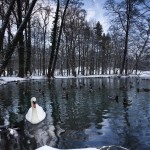Duck tape – Photographer’s best friend
As we all know using filters is probably the best way to give your photos a creative component, even without post-processing. But manipulating filters can be a tricky task, especially with system filters.
In this example we will try to longer the exposure during intense sunlight, and at the same time make highly contrast black and white photos.

First of all, we have to decide what filters to use. If you can, you should definitely use a polarizing filter, because it alone can really make a difference in contrast. Because of the wide angle lens, I can only use a slim polarizing filter which doesn’t have a mount on the other side, so I couldn’t have used it here.
A must have filter here is the absolute red filter (here is cokin P003). The main idea of this filter is to enhance the difference between land and sky, making the sky almost absolutely black. It will also enhance the overall contrast when converted in B&W at post-processing.
To avoid problems with exposure due to massive difference between land and sky, you could use some kind of graduated ND filter. Here is ND8 (or at some manufactures you can find it named 0.9).

Full ND filter will definitely come in handy, because it can lenghten the exposure for a few stops. Here in this example is ND8 (0.9). It prolongs the exposure by 3 f-stops.
Secondly, we got to get rid of the spare light. When the exposure is longer, there is a higher chance the extra light will get on the sensor trough the spaces between the filters.
To avoid that, we will use a duck-tape. I would suggest using a white tape, because it will reflect the maximum amount of light. Some manufacturers offer modular hoods to avoid such problems, but why waste your money when you can do it at home?
 Be gentle while pasting the tape. The idea is to make the tape last for duration of the session, not a couple of days. Also, when done photographing, remove the tape as soon as you can because if you leave it on too long, the glue could remove the paint from some of the painted filters (like cokin’s P003)
Be gentle while pasting the tape. The idea is to make the tape last for duration of the session, not a couple of days. Also, when done photographing, remove the tape as soon as you can because if you leave it on too long, the glue could remove the paint from some of the painted filters (like cokin’s P003)
 One other thing you must do while shooting, is to cover the viewfinder during the exposure. This is one little thing many photographers ignore, simply because of laziness. Leaving the viewfinder open can make the photometer give false data, and it can also degrade the quality of the overall photo, sometimes leaving artifacts on borders. Many camera models come equipped with a viewfinder cover that is attached to the strap. You can also use a duck-tape
One other thing you must do while shooting, is to cover the viewfinder during the exposure. This is one little thing many photographers ignore, simply because of laziness. Leaving the viewfinder open can make the photometer give false data, and it can also degrade the quality of the overall photo, sometimes leaving artifacts on borders. Many camera models come equipped with a viewfinder cover that is attached to the strap. You can also use a duck-tape
And lastly, after shooting, it is time to post-process the photos. I really can’t give you any advice here. The best way is to experiment.







imaš dobrih tekstova, stavio sam te u preporuku :)
pitanje, jel imaš problem s vinjetiranjem? Frend je kupio za 12-24 na nikonu i javlja mu se vinjetiranje…ja osobno nekako više vjerujem onim klasičnim filterima sa navojem i ne trebam duck tape :)
Type your comment here
hvala ti :) stavit ću i ja tebe, već odavno namjeravam al uvijek zaboravim :D
što se tiće vinjetiranja nemam problema (iako osobno jako volim vinjetiranje :D ). možda bi imao problema da ne koristim sa svim tim filterima fokalne duljine od 12 ili više mm (objektiv je od 10-22mm) zato jer imam P seriju filtera koja nisu dovoljno velika da pokriju sve pri 10mm. mislim da sam čak imao više vinjetiranja s kit objektivom (18-55mm), al mislim da je većina bila od polarizatora.
na ovom objektivu koristim slim CPL koji uopće ne vinjetira.
Inače ovaj duck-tape nije obavezan pri normalnim uvijetima, samo pri dužim ekspozicijama. inače postoji i prilično jeftino sjenilo za filtere koje pokriva sve ovo obljepljeno trakom, al ovo je ipak najsigurnije (i najkompliciranije :D )
ja sam imao prilije imat u rukama 12-24 f:2.8 i to na FF-u. mrak stvar, al mi nije jasno di je stavljao te filtere. taj objektiv izvana izgleda ko fish (ili žarulja :D ). mislim da filteri idu samo unutra (između senzora i objektiva)… il sam ja gledao drugo staklo.
prvi put čujem za ovo pokrivanje viewfindera. to vrijei za eos-e? pretpostavljam uglavnom kod dužih ekspozicija i remote fotkanja ili ovo sa stativom?
To vrijedi za sve SLR-ove.
kad fotoaparat eksponira, svjetlost “curi” na senzor iz viewfindera. čista mehanika :)
kod normalnih fotki to je zanemarivo zbog male vremenske razlike i činjenice da je viewfinder uglavnom prekriven našim očima :)
na svim eosima (a vjerujem i kod ostalih proizvođača) imaš malu kapicu na remenu za nošenje koja taman paše na viewfinder i služi upravo ovome.